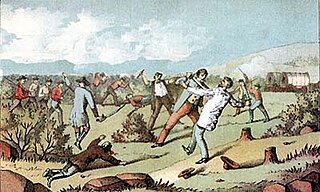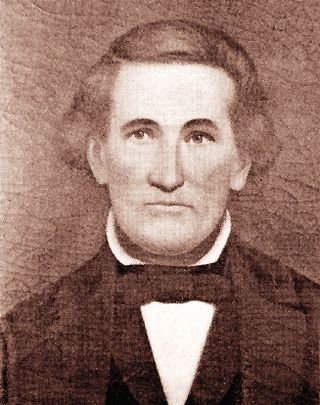
The Danites were a fraternal organization founded by Latter Day Saint members in June 1838, in the town of Far West, Caldwell County, Missouri. During their period of organization in Missouri, the Danites operated as a vigilante group and took a central role in the events of the 1838 Mormon War. They remained an important part of Mormon and non-Mormon folklore, polemics, and propaganda for the remainder of the 19th century, waning in ideological prominence after Utah gained statehood. Notwithstanding public excommunications of Danite leaders by the Church and both public and private statements from Joseph Smith referring to the band as being both evil in nature and a "secret combination", the nature and scope of the organization and the degree to which it was officially connected to the Church of Christ are not agreed between historians. Early in the group's existence, Joseph Smith appeared to endorse its actions, but later turned against it as violence increased and the actions of the Danites inspired a hysteria in Missouri that eventually led to the Extermination Order. According to an essay on the website of the Church of Jesus Christ of Latter-day Saints, "Historians generally concur that Joseph Smith approved of the Danites but that he probably was not briefed on all their plans and likely did not sanction the full range of their activities."

According to Latter Day Saint belief, the golden plates are the source from which Joseph Smith translated the Book of Mormon, a sacred text of the faith. Some accounts from people who reported handling the plates describe the plates as weighing from 30 to 60 pounds, gold in color, and composed of thin metallic pages engraved with hieroglyphics on both sides and bound with three D-shaped rings.

Oliver H. P. Cowdery was an American religious leader who, with Joseph Smith, was an important participant in the formative period of the Latter Day Saint movement between 1829 and 1836. He was the first baptized Latter Day Saint, one of the Three Witnesses of the Book of Mormon's golden plates, one of the first Latter Day Saint apostles and the Assistant President of the Church.

The Church of Christ was the original name of the Latter Day Saint church founded by Joseph Smith. Organized informally in 1829 in Upstate New York and then formally on April 6, 1830, it was the first organization to implement the principles found in Smith's newly published Book of Mormon, and thus its establishment represents the formal beginning of the Latter Day Saint movement. Later names for this organization included the Church of the Latter Day Saints, the Church of Jesus Christ, the Church of God, the Church of Christ of Latter Day Saints, and the Church of Jesus Christ of Latter Day Saints.

According to Latter Day Saint theology, seer stones were used by Joseph Smith, as well as ancient prophets, to receive revelations from God. Members of the Church of Jesus Christ of Latter-day Saints believe that Smith used seer stones to translate the Book of Mormon.

David Whitmer was a leader in the Church of Jesus Christ of Latter Day Saints who eventually became the most interviewed of the Three Witnesses to the Book of Mormon's golden plates.

Joseph Smith Sr. was the father of Joseph Smith Jr., the founder of the Latter Day Saint movement. Joseph Sr. was also one of the Eight Witnesses of the Book of Mormon, which Mormons believe was translated by Smith Jr. from golden plates. In 1833, Smith Sr. was named the first patriarch of the Church of Christ. Joseph Sr. was also a member of the First Presidency of the church.
Mary Elsa Musselman Whitmer was a Book of Mormon witness and the wife of Peter Whitmer Sr.

The Three Witnesses is the collective name for three men connected with the early Latter Day Saint movement who stated that an angel had shown them the golden plates from which Joseph Smith translated the Book of Mormon; they also stated that they had heard God's voice, informing them that the book had been translated by divine power. The Three are part of twelve Book of Mormon witnesses, who also include Smith and the Eight Witnesses.
Peter Whitmer Sr. was an early member of the Latter Day Saint movement, and father of the movement's second founding family.
Hiram Page was an early member of the Latter Day Saint movement and one of the Eight Witnesses to the Book of Mormon's golden plates.

Jacob Whitmer was the second born child of Peter Whitmer, Sr., and Mary Musselman. He is primarily remembered as one of the Eight Witnesses of the Book of Mormon’s golden plates.
Joseph Smith was an American religious leader and the founder of the Latter Day Saint movement whose current followers include members of the Church of Jesus Christ of Latter-day Saints, the Community of Christ, and other Latter Day Saint denominations. The early life of Joseph Smith covers his life from his birth to the end of 1827.

The life of Joseph Smith from 1827 to 1830, when he was 22–25 years old, begins in late 1827, after Smith announced he had obtained a book of golden Plates buried in a hill near his home in Manchester, New York. Because of opposition by former treasure-seeking colleagues who believed they owned a share of the golden plates, Smith prepared to leave the Palmyra area for his wife's home town of Harmony, Pennsylvania. From late 1827 to the end of 1830, Smith would translate the golden plates, publish the Book of Mormon, and establish the Church of Christ.

The Book of Mormon witnesses were a group of contemporaries of Joseph Smith who claimed to have seen the golden plates from which Smith translated the Book of Mormon. The most significant witnesses were the Three Witnesses and the Eight Witnesses, all of whom allowed their names to be used on two separate statements included with the Book of Mormon. Critics have challenged the nature and reliability of the accounts, but church leaders contend that none of the witnesses ever denied what they saw.

The Peter Whitmer log home is a historic site located in Fayette, New York, United States, owned and operated by the Church of Jesus Christ of Latter-day Saints. The current house is a replica of the original log cabin and at its original site, and was built in 1980 to mark the sesquicentennial of the founding of the church. In the early 19th century, it was the home of Peter Whitmer Sr., his wife Mary Musselman Whitmer, and their eight children: Christian, Jacob, John, David, Catherine, Peter Jr., Nancy, and Elizabeth Ann, who lived on the property from 1809 to 1830. The house is prominent in the early history of the Latter Day Saint movement as the traditional location of the formal organization of the Church of Christ, the original name of the church founded by Joseph Smith on April 6, 1830. The home is also near the site where the Three Witnesses were shown the golden plates by the Angel Moroni in 1829. Joseph Smith and his wife Emma lived in the home with the Whitmers for six months in 1829, with a large part of the Book of Mormon being translated during that time. The house and adjacent visitor center are open year-round for public tours.

This is a chronology of Mormonism. In the late 1820s, Joseph Smith, founder of the Latter Day Saint movement, announced that an angel had given him a set of golden plates engraved with a chronicle of ancient American peoples, which he had a unique gift to translate. In 1830, he published the resulting narratives as the Book of Mormon and founded the Church of Christ in western New York, claiming it to be a restoration of early Christianity.
Early participants in the Latter Day Saint movement consist of those individuals who were involved in Joseph Smith's Latter Day Saint movement prior to Smith's departure for Ohio in January 1831. Early participants also included the Three Witnesses and the Eight Witnesses to the Book of Mormon and members of the extended Whitmer and Smith families. Other early members included friends and acquaintances of the Smith and Whitmer families, such as Orrin Porter Rockwell.

The following outline is provided as an overview of and topical guide to the Book of Mormon:

The following outline is provided as an overview of and topical guide to the life and influence of Joseph Smith:















